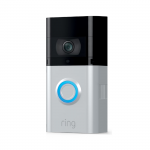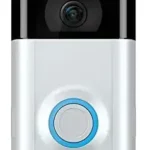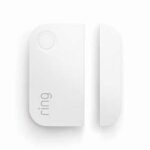This user manual for the Ring Video Doorbell shows you how to correctly install the device using the bracket. It also shows you how to initially set the doorbell up using the app and how to answer the door using it too.

Ring Video Doorbell
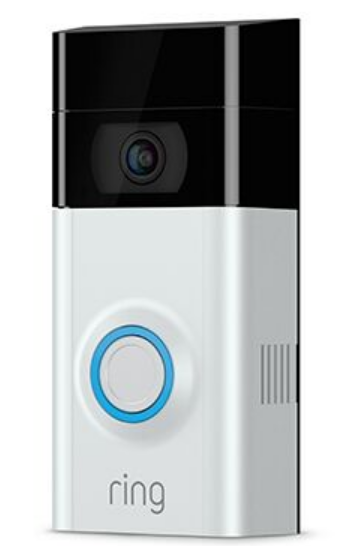
Powering Your Ring
Charge your Ring Doorbell before installation using the supplied orange cable.
While charging, the circular light on the front of your Ring will let you know the percentage it’s charged. 
If you have an existing doorbell Ring can run off its existing power supply for a continuous charge (see step 6). NOTE: Ring is not compatible with most intercom systems.
If you don’t have an existing doorbell Ring can run off its built-in battery and last 6-12 months between charges. If you receive frequent motion events, you may need to charge your Ring more frequently.
Getting Ready for Setup
Say “Hello” to the back of your Ring Doorbell
Setup Button – You’ll be instructed to push the orange setup button during the in-app setup (see step 3).
While in setup mode, the light on the front of your Ring Doorbell will spin.
Charging Port – Plug the orange cable into the charging port to charge your Ring Doorbell. 
Step 1
Download the Ring app
The Ring app will walk you through the entire installation process, but if you prefer to reference a hard copy, use this manual.
Visit: ring.com/app
Visit the online setup guide for extra help
We also have an online guide with videos and tutorials to help you set up and use your Ring Video Doorbell.
Visit: ring.com/setup
Step 2
Perform the in-app setup
The Ring app will walk you through this process. Download the Ring app by visiting ring.com/app
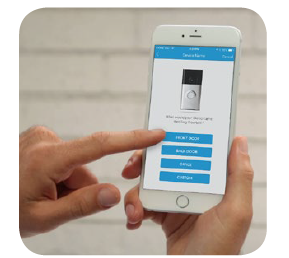
Tap the plus sign in the Ring app to set up a new device, and select Video Doorbell when prompted.
Perform in-app setup near your router. You’ll need your network name and Wi-Fi password..
Step 3
Push the front button to test the video
While inside near your router, push the button on the front of your doorbell to see live video in the Ring app. Then, perform this same test while outside. 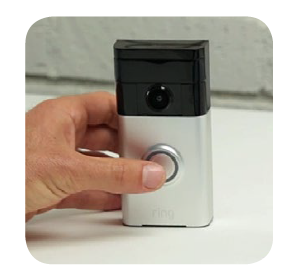
If video quality is not as good outdoors as it was indoors, you may need to move your router closer to your door or invest in a Wi-Fi extender.
Learn more at: ring.com/extender
Step 4
Remove your existing doorbell (optional)
If you’re replacing a wired doorbell, first turn off the power at the breaker. Then, remove your doorbell from the wall, and disconnect the wires. 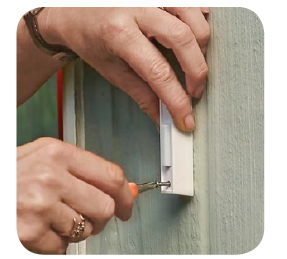
If your existing doorbell has a diode, you’ll need to use the diode included with your Ring Doorbell for installation.
Step 5
Install the mounting bracket
Take everything that came in the box (along with a power drill if you’re installing on stucco, brick or concrete), to the spot where you’re installing your Ring Doorbell.
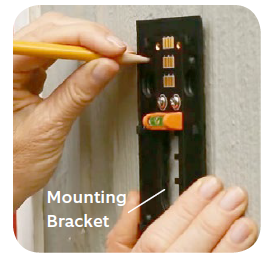
Snap the provided level onto the mounting bracket, and align the bracket accordingly.
Then, remove the orange tape, and use the mounting bracket as a template to mark four corner holes for your screws.
Installing the mounting bracket (continued)
On stucco, brick or concrete, install the anchors using the provided drill bit and a power drill before installing the mounting bracket.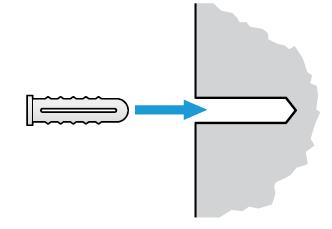
On wood or siding, you can skip this part and screw the bracket directly onto your wall.
If you have one, it may help to use a smaller drill bit to drill pilot holes first.
Installing the mounting bracket (continued)
Drive the screws into the anchors or directly into the wall until they’re flush with the mounting bracket and the bracket is flat against the wall. 
If the wall isn’t flat, make sure you don’t screw the bracket in so tightly that it bends.
Step 6
Connect the wires (optional)
Connect the wires coming out of your wall to the screws on the bracket. Note that it doesn’t matter which wire connects to which screw. 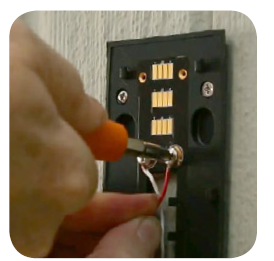
The wiring must be connected to a transformer with a voltage of 8VAC – 24VAC and an internal doorbell or resistor.
DC transformers and (therefore) most intercoms are not supported.
How and when to use the diode
If your doorbell is digital (i.e. plays a melody), attach the included diode to the two screws on your bracket.
If it’s mechanical (i.e. goes “ding-dong”), DO NOT use the diode.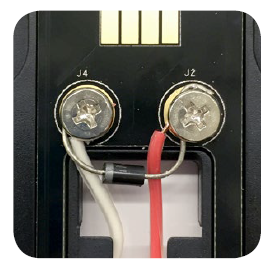
If you have a digital doorbell, connecting the diode the wrong way won’t do any harm. If your doorbell doesn’t ring, just reverse the diode.
Learn more at ring.com/diode
Step 7
Attach Ring Doorbell to the bracket
Line up the holes in your Ring Doorbell with the slots on the bracket. Push firmly towards the wall and then down until you feel a click.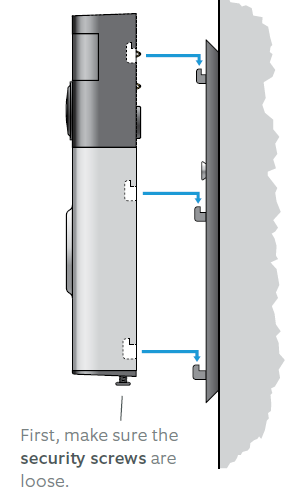
Step 8
Secure your Ring Doorbell
Use the star-shaped end of your Ring screwdriver to tighten the security screws on the bottom of your Ring Doorbell.
Then, restore power at the breaker.
Ring Light Patterns
The front light on your Ring Doorbell uses a number of patterns to communicate messages.
Here are some common ones: 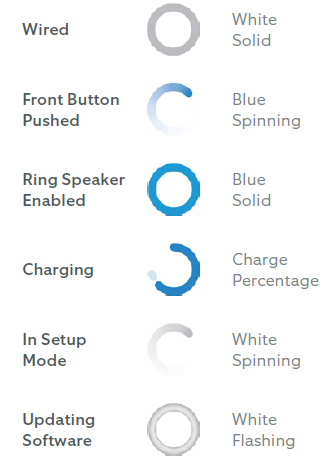
Answering Your Door
When someone is at your door, you can perform the following actions: 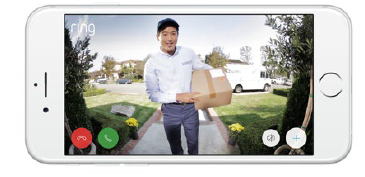
- Disable/enable your microphone
- Mute/unmute your speaker
- Zoom in/out
- Access the Ring Plus menu
Turning alerts on or off:
You can toggle alerts for Rings or Motions on or off in the Ring app. 
Need Help?
For additional help, visit: ring.com/help
For immediate assistance, we’re available 7 days a week at: 01727 263045
For a list of all our customer support numbers, visit: ring.com/callus
FCC Rules
This device complies with Part 15 of the FCC Rules. Operation is subject to the following two conditions:
- this device may not cause harmful interference, and
- this device must accept any interference received, including interference that may cause undesired operation.
For best results, use type Li-Ion batteries. Install only new batteries of the same type in your product. Failure to insert batteries in the correct polarity, as indicated in the battery compartment, may shorten the life of the batteries or cause batteries to leak. Do not mix old and new batteries. Do not mix Alkaline, Standard (Carbon-Zinc) or Rechargeable (Nickel Cadmium) or (Nickel Metal Hydride) batteries. Do not dispose of batteries in fire. Batteries should be recycled or disposed of as per state and local guidelines.
Warning: Changes or modifications to this unit not expressly approved by the party responsible for compliance could void the user’s authority to operate the equipment.
NOTE: This equipment has been tested and found to comply with the limits for a Class B digital device, pursuant to Part 15 of the FCC Rules. These limits are designed to provide reasonable protection against harmful interference in a residential installation. This equipment generates, uses and can radiate radio frequency energy and, if not installed and used in accordance with the instructions, may cause harmful interference to radio communications.
However, there is no guarantee that interference will not occur in a particular installation. If this equipment does cause harmful interference to radio or television reception, which can be determined by turning the equipment off and on, the user is encouraged to try to correct the interference by one or more of the following measures:
- Reorient or relocate the receiving antenna.
- Increase the separation between the equipment and receiver.
- Connect the equipment into an outlet on a circuit different from that to which the receiver is connected.
- Consult the dealer or an experienced radio/TV technician for help.
Hereby, Bot Home Automation, declares that this consumer electronic is in compliance with the essential requirements and other relevant provisions of Directive 1999/5/EC. The declaration of conformity may be consulted at www.ring.com/DoC.pdf.
Protect the device from direct sunlight. Install the device at dry locations and protect it against rain and humidity. The device may not get contact to salt water or other conductive liquids. The device must be charged only within a building in a dry state.
